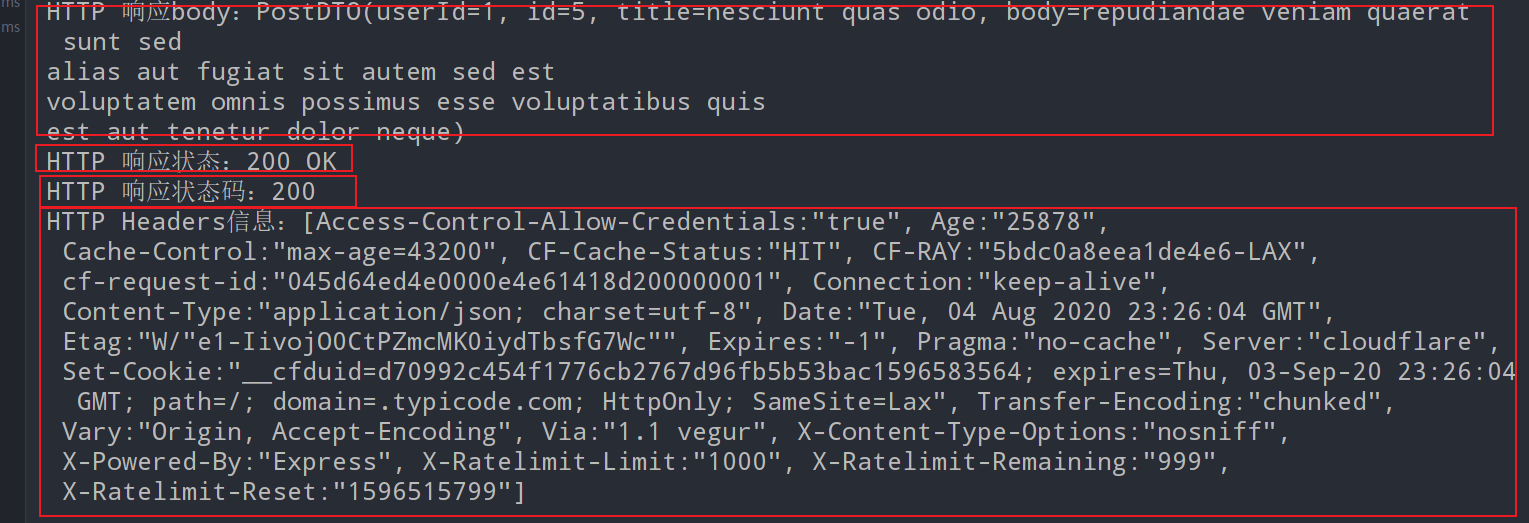您好,登录后才能下订单哦!
这篇文章给大家分享的是有关RestTemplate GET请求怎么用的内容。小编觉得挺实用的,因此分享给大家做个参考,一起跟随小编过来看看吧。
在Spring Boot环境下写一个单元测试用例,以String类型接收响应结果信息
@SpringBootTestclass ResttemplateWithSpringApplicationTests { @Resource private RestTemplate restTemplate; @Test void testSimple() { String url = "http://jsonplaceholder.typicode.com/posts/1"; String str = restTemplate.getForObject(url, String.class); System.out.println(str); }}getForObject第二个参数为返回值的类型,String.class以字符串的形式接受getForObject响应结果,

在Spring Boot环境下写一个单元测试用例,以java POJO对象接收响应结果信息
@Testpublic void testPoJO() { String url = "http://jsonplaceholder.typicode.com/posts/1"; PostDTO postDTO = restTemplate.getForObject(url, PostDTO.class); System.out.println(postDTO.toString());}输出打印结果如下:

POJO的定义如下,根据JSON String的数据格式定义。
@Datapublic class PostDTO { private int userId; private int id; private String title; private String body;}访问http://jsonplaceholder.typicode.com/posts 可以获得JSON数组方式的请求结果

下一步就是我们该如何接收,使用方法也很简单。在Spring Boot环境下写一个单元测试用例,以数组的方式接收请求结果。
@Testpublic void testArrays() { String url = "http://jsonplaceholder.typicode.com/posts"; PostDTO[] postDTOs = restTemplate.getForObject(url, PostDTO[].class); System.out.println("数组长度:" + postDTOs.length);}请求的结果被以数组的方式正确接收,输出如下:
数组长度:100
以下的几个请求都是在访问"http://jsonplaceholder.typicode.com/posts/1",只是使用了占位符语法,这样在业务使用上更加灵活。
使用占位符的形式传递参数:
String url = "http://jsonplaceholder.typicode.com/{1}/{2}";PostDTO postDTO = restTemplate.getForObject(url, PostDTO.class, "posts", 1);另一种使用占位符的形式:
String url = "http://jsonplaceholder.typicode.com/{type}/{id}";String type = "posts";int id = 1;PostDTO postDTO = restTemplate.getForObject(url, PostDTO.class, type, id);我们也可以使用 map 装载参数:
String url = "http://jsonplaceholder.typicode.com/{type}/{id}";Map<String,Object> map = new HashMap<>();map.put("type", "posts");map.put("id", 1);PostDTO postDTO = restTemplate.getForObject(url, PostDTO.class, map);上面的所有的getForObject请求传参方法,getForEntity都可以使用,使用方法上也几乎是一致的,只是在返回结果接收的时候略有差别。使用ResponseEntity<T> responseEntity来接收响应结果。用responseEntity.getBody()获取响应体。响应体内容同getForObject方法返回结果一致。剩下的这些响应信息就是getForEntity比getForObject多出来的内容。
HttpStatus statusCode = responseEntity.getStatusCode();获取整体的响应状态信息int statusCodeValue = responseEntity.getStatusCodeValue(); 获取响应码值HttpHeaders headers = responseEntity.getHeaders();获取响应头等
@Testpublic void testEntityPoJo() { String url = "http://jsonplaceholder.typicode.com/posts/5"; ResponseEntity<PostDTO> responseEntity = restTemplate.getForEntity(url, PostDTO.class); PostDTO postDTO = responseEntity.getBody(); // 获取响应体 System.out.println("HTTP 响应body:" + postDTO.toString()); //以下是getForEntity比getForObject多出来的内容 HttpStatus statusCode = responseEntity.getStatusCode(); // 获取响应码 int statusCodeValue = responseEntity.getStatusCodeValue(); // 获取响应码值 HttpHeaders headers = responseEntity.getHeaders(); // 获取响应头 System.out.println("HTTP 响应状态:" + statusCode); System.out.println("HTTP 响应状态码:" + statusCodeValue); System.out.println("HTTP Headers信息:" + headers);}输出打印结果

感谢各位的阅读!关于“RestTemplate GET请求怎么用”这篇文章就分享到这里了,希望以上内容可以对大家有一定的帮助,让大家可以学到更多知识,如果觉得文章不错,可以把它分享出去让更多的人看到吧!
免责声明:本站发布的内容(图片、视频和文字)以原创、转载和分享为主,文章观点不代表本网站立场,如果涉及侵权请联系站长邮箱:is@yisu.com进行举报,并提供相关证据,一经查实,将立刻删除涉嫌侵权内容。